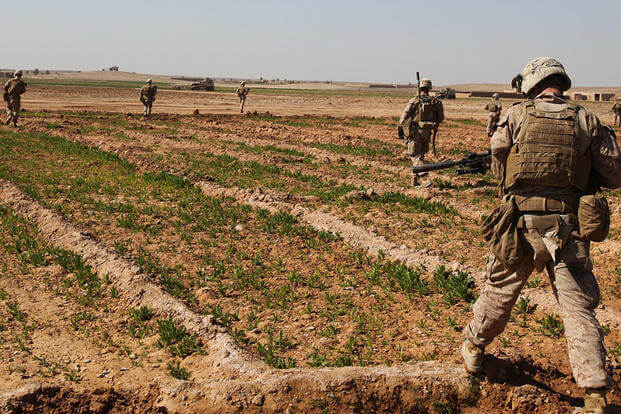More than two years after departing Afghanistan as a fighting force, the Marine Corps may be sending troops back into the country in an advisory capacity.
Maj. Gen. John Love, commander of the 2nd Marine Division, in recent months said that an element of the Camp Lejeune-based unit would be deploying to Afghanistan in the spring.
"There is change in the air," Love said at a Marine Corps Association and Foundation awards event in November. "There is a new mission we've picked up in the Marine Corps. We are going to repurpose the infantry regiments against a new mission back in some familiar territory in Afghanistan, a province we've been to before and a location we've been to before."
The mission: to advise the Afghan National Security Forces and the police forces, he said.
Marines previously served in Helmand, the Taliban hotbed in the southwest region of the country -- and senior Marine advisers kept a team in Lashkar Gah, Helmand's capital and the headquarters of its police force.
Speaking to Military.com the same day, Love said the Marine Corps element, the size and identity of which he would not disclose, would be taking over for an Army element with the same mission.
"We've had advisers in Afghanistan ever since we concluded our major operations there, so the Marine Corps is going to pick up another one of those advisory missions that the Army's been doing," he said. "So the Army has been doing it, and the Marine Corps is going to go in and take over one of their teams for them."
A spokesman for Marine Corps Central Command, Maj. Brad Avots, would not confirm the deployment of troops Love mentioned.
"For operational security reasons, I don't have anything to provide on potential future force movements," he said in a statement provided to Military.com. "The U.S. Marine Corps and MARCENT stand ready to support any emergent requirements by the CENTCOM combatant commander."
But another senior Marine officer, Col. Martin Wetterauer, commander of the 8th Marine Regiment, also mentioned the deployment during a December briefing following a tour with the Marines' crisis response force for Africa.
"Second Marine Division regiments are going back to Afghanistan in April," he said. "Sixth Marines is going to be put against the southwest mission.”
Roughly 10,000 U.S. troops remain in Afghanistan. In a shift, President Barack Obama announced last July the presence will remain higher than expected this year -- at more than 8,000, up from a projected 5,500 troops. The majority of these troops are soldiers supporting Afghan National Security Forces in advise-and-assist roles in regions that played major roles during the 13-year war, including Bagram, Kabul, Jalalabad and Kandahar.
For the Marine Corps, the service's presence in Afghanistan has been limited to small 100-man liaison teams deploying alongside Georgian troops to regions including Bagram in a partnership program that began earlier in the war.
What remains unclear is the strategy in play behind sending more Marines in to assist the Army in the advisory mission.
The Corps' most significant moments and gains in the war took place in Helmand province, the location of the sprawling Camp Leatherneck headquarters and adjoining British base, Camp Bastion. The entire complex was handed over to Afghan forces with the Afghan National Army's 215th Corps when the Marines pulled all troops out of Helmand in November 2014.
Helmand was also the site of some of the most costly fights of the war. Marines launched lengthy campaigns in regions including Marjah and Sangin to root out Taliban in their remaining strongholds. As the Corps pulled out of Sangin in spring 2014, Marine officials celebrated leaving the region peaceful, with stable leadership and sharply reduced Taliban violence.
But the picture following the pullout has been less rosy.
Taliban forces have surged in Helmand, joined in some places by Islamic State-affiliated militants. In February, hundreds of troops from the Army's 10th Mountain Division pushed into Helmand to assist the ANA 215th Corps, serving as force protection for military advisers and trainers already in the area amid Taliban attacks.
Earlier this week, a spokesman for Helmand said that Taliban activity was ramping up in Marjah and Sangin, ahead of the start of the group's traditional fighting season in the spring.
-- Hope Hodge Seck can be reached at hope.seck@military.com. Follow her on Twitter at @HopeSeck.





























